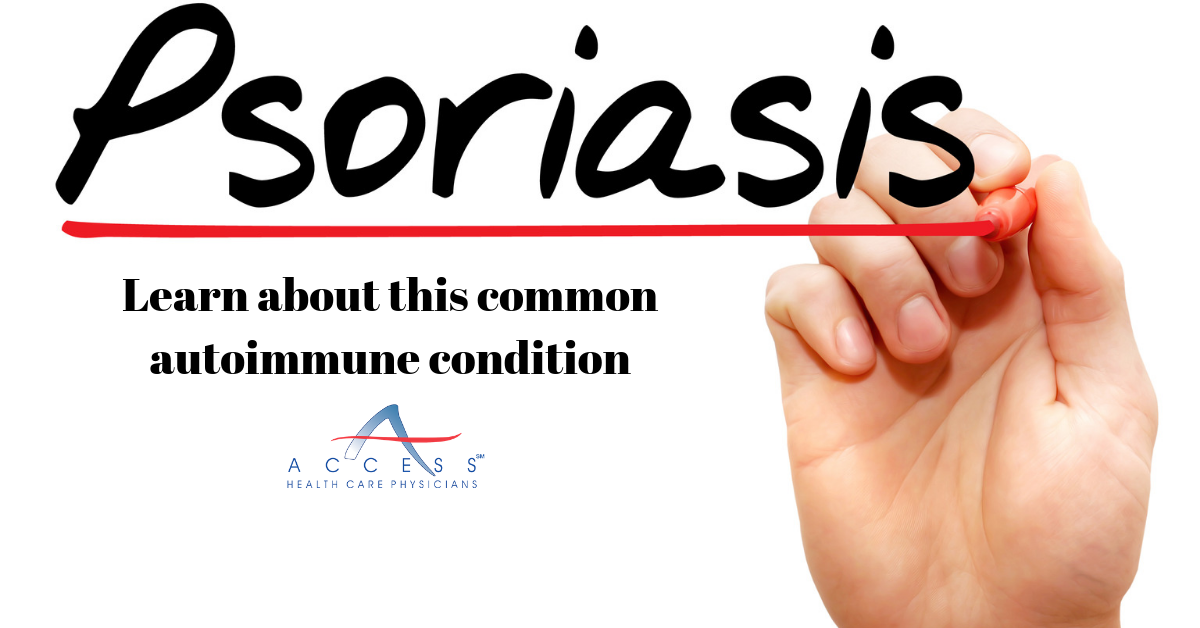Psoriasis is a type of autoimmune condition that forms a buildup of cells on the skin’s surface. This buildup causes the scaly skin that is commonly associated with psoriasis. When skin cells develop, they begin deep under the skin and make their way to the surface where they eventually fall off. In the average person, this process takes around a month from start to finish. In a person with psoriasis, this process is completed in a shorter amount of time, often in just a few days. This rapid process does not give the old skin cells time to fall off, causing the skin to appear scaly.
It is important to note that Psoriasis is NOT Contagious. This is a common misconception. Psoriasis cannot be spread by touch or sharing of bodily fluid. Psoriasis is an autoimmune disease, which is when the body mistakenly sends white blood cells to attack skin cells, forcing the skin cells to produce at a rapid rate.
While not confirmed, many doctors believe that the odds of someone developing psoriasis may be linked to genetics. That if an immediate family member has this skin condition, the chances for developing psoriasis increase.
Symptoms
Scaly patches of skin are the most common symptom of psoriasis. These scales typically appear around the joints but can form anywhere on the body, including the neck, head, hands, and feet. Less common types of psoriasis may affect the mouth and genitals. Those suffering from psoriasis often have inflamed patches of skin, itching, burning, and soreness around patches, painful joints, and dry skin that often cracks and bleeds.
It is important to remember that not everyone experiences psoriasis the same way. Often those with psoriasis go through cycles that fluctuate the severity of their symptoms. The symptoms may disappear completely for a time but that does not mean that their psoriasis will not come back. Psoriasis also comes in many different forms that may not present the same symptoms.
Types of Psoriasis
Plaque Psoriasis
This is the most common type of psoriasis. The American Academy of Dermatology (ADD) states that around 80 percent of those suffering from psoriasis, suffer from plaque psoriasis. This type causes inflamed patches that are often also covered with whitish scales. Typically, these patches cover areas of the knees, elbows, and scalp.
Pustular Psoriasis
Typically found in adults, pustular psoriasis causes pus-filled blisters along with areas of inflamed skin. This type of psoriasis usually forms on the hands and feet but can form anywhere on the body
Inverse Psoriasis
This type of psoriasis forms bright red, shiny areas of skin. Flare-ups for inverse psoriasis are usually found in areas where sweat accumulates, like the armpits, groin, under breasts, and around the genitals.
Guttate Psoriasis
Guttate Psoriasis is typically found in children, causing small pink spots that are rarely raised or thick like most types of psoriasis. These guttate psoriasis spots are usually found on the torso and limbs.
Erythrodermic Psoriasis
Erythrodermic psoriasis is a rare and severe form of psoriasis that requires immediate medical attention. Larger patches form across large sections of the body and look similar to a sunburn. The scales that develop as a result of Erythrodermic psoriasis may fall off in large sheets and it is common for someone suffering from this form of psoriasis to run high fevers and to become very sick.
Psoriatic Arthritis
Psoriatic arthritis is a condition that combines the itchy scaly patches of psoriasis with the sore, swollen joints of arthritis. 30 percent of the people who develop psoriasis end up with a form of psoriatic arthritis.
Treatments
There is no cure for psoriasis. The treatments of this disease aim to slow the growth of skin cells and reduce the size and severity of the patches.
Typically, treatments begin with topical creams and ointments, such as moisturizers, topical corticosteroids, and topical retinoid creams. If the psoriasis is severe enough, doctors can prescribe oral or injectable medications to treat the symptoms. These medications often have severe side effects, such as liver damage, reduced white blood cells, and kidney problems, so they generally prescribe them for short periods of time. Another option is light therapy. Light therapy uses ultraviolet or natural light to kill the white blood cells that are attacking healthy skin.
Triggers
Psoriasis may become worse when certain stressors affect the body. Infections and injuries to the skin often cause flare-ups due to the body’s immune response going into overdrive to rid itself of bacteria. Certain medications are considered psoriasis triggers, including high blood pressure medications and medications containing lithium.
Stress and alcohol can induce flare-ups as well. Those who learn to manage their stress and avoid alcohol can limit flare-ups. Limiting foods that increase inflammation, such as refined sugars, dairy, and processed foods, will also reduce flare-ups in those suffering from psoriasis.
Emotional Impact
With more and more people being diagnosed with psoriasis, it is important that we spread awareness of this disease and help those who suffer. Many with this condition experience problems self-esteem and depression. Psoriasis is a visible condition, causing many people to feel ashamed. This is made worse when others believe the myths that psoriasis is contagious or simply look down on them for the appearance of their skin.
With a little awareness, those suffering from psoriasis may live happier and healthier lives!
For more informational blogs, be sure to follow us on Facebook, Instagram and check our blog page often.
Written by Devyn Maves for Access Health Care Physicians, LLC.


